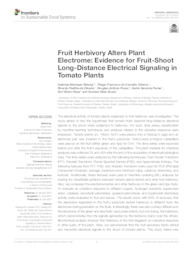Fruit herbivory alters plant electrome: evidence for fruit-shoot long-distance electrical signaling in tomato plants.
Fruit herbivory alters plant electrome: evidence for fruit-shoot long-distance electrical signaling in tomato plants.
Author(s): REISSIG, G. N.; OLIVEIRA, T. F. DE C.; OLIVEIRA, R. P. de; POSSO, D. A.; PARISE, A. G.; NAVA, D. E.
Summary: The electrical activity of tomato plants subjected to fruit herbivory was investigated. The study aimed to test the hypothesis that tomato fruits transmit long-distance electrical signals to the shoot when subjected to herbivory. For such, time series classification by machine learning techniques and analyses related to the oxidative response were employed. Tomato plants (cv. ?Micro-Tom?) were placed into a Faraday?s cage and an electrode pair was inserted in the fruit?s peduncle. Helicoverpa armigera caterpillars were placed on the fruit (either green and ripe) for 24 h. The time series were recorded before and after the fruit?s exposure of the caterpillars. The plant material for chemical analyses was collected 24 and 48 h after the end of the acquisition of electrophysiological data. The time series were analyzed by the following techniques: Fast Fourier Transform (FFT), Wavelet Transform, Power Spectral Density (PSD), and Approximate Entropy. The following features from FFT, PSD, and Wavelet Transform were used for PCA (Principal Component Analysis): average, maximum and minimum value, variance, skewness, and kurtosis. Additionally, these features were used in Machine Learning (ML) analyses for looking for classifiable patterns between tomato plants before and after fruit herbivory. Also, we compared the electrome before and after herbivory in the green and ripe fruits. To evaluate an oxidative response in different organs, hydrogen peroxide, superoxide anion, catalase, ascorbate peroxidase, guaiacol peroxidase, and superoxide dismutase activity were evaluated in fruit and leaves. The results show with 90% of accuracy that the electrome registered in the fruit?s peduncle before herbivory is different from the electrome during predation on the fruits. Interestingly, there was also a sharp difference in the electrome of the green and ripe fruits? peduncles before, but not during, the herbivory, which demonstrates that the signals generated by the herbivory stand over the others. Biochemical analysis showed that herbivory in the fruit triggered an oxidative response in other parts of the plant. Here, we demonstrate that the fruit perceives biotic stimuli and transmits electrical signals to the shoot of tomato plants. This study raises new possibilities for studies involving electrical signals in signaling and systemic response, as well as for the applicability of ML to classify electrophysiological data and its use in early diagnosis.
Publication year: 2021
Types of publication: Journal article
Keywords: Helicoverpa amigera, Stress response, Tomate
Observation
Some of Embrapa's publications are published as ePub files. To read them, use or download one of the following free software options to your computer or mobile device. Android: Google Play Books; IOS: iBooks; Windows and Linux: Calibre.
Access other publications
Access the Agricultural Research Database (BDPA) to consult Embrapa's full library collection and records.
Visit Embrapa Bookstore to purchase books and other publications sold by Embrapa.

